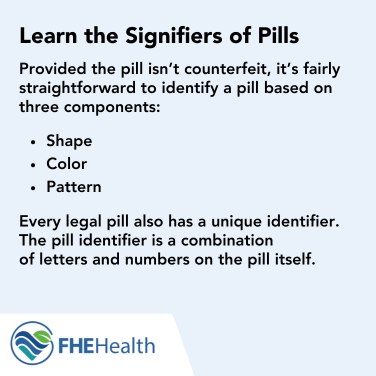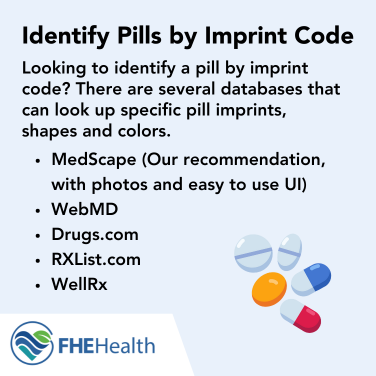
Have you just picked up your prescription and want to confirm the pharmacist dispensed the correct drug? Perhaps you’re caring for an elderly parent and need to know you’re giving them the right pills at different times of the day. Sometimes, you may encounter an unknown pill on the street or in your mailbox.
Whatever the scenario, learning how to use a pill identifier can keep you and your loved ones safe – especially at a time when potentially deadly fentanyl pills are popping up all over the country. Valuable tools include the pill ID from your prescription bottle, online resources, and your pharmacist or health care provider
What is an “ID-Unknown Pill”?
Medications aren’t always easy to identify by appearance or packaging. These “ID-Unknown” pills often lack clear markings or labels, might come from an unknown source, or may have lost their labels. Medications usually become ID-unknowns when removed from their original packaging, either by individuals or certain providers who repackage drugs. Sometimes, people might acquire medicines from unreliable sources, such as unregulated online pharmacies.
It may seem like common sense, but you should never consume a pill unless you can identify it. Reliable identification helps prevent harm caused by taking an incorrect medication with potentially serious side effects. Certain drugs can be dangerous for some individuals due to existing medical conditions. In extreme cases, ingesting an unknown pill could lead to hospitalization and even death. Regardless of the circumstances, there may come a time when it’s life-saving to identify a pill correctly.
Causes and Risks
The most common reason pills become hard to identify is removing them from labeled bottles. Outside the original packaging, vital details like the drug’s name, dosage, and expiration date may be lost. Over time, labels can fade, peel, or become smudged. Even the original packaging may not help if the label is ineligible.
A lot of people with chronic conditions use convenience items such as pill organizers. While these can be useful, they’re also a source of mix-ups. Pills stored without proper separation can be misplaced, and people can mistake similar-looking pills for one another.

Ingesting an unidentified pill can cause adverse drug reactions. A medication taken by mistake can interact with other drugs in the person’s system. There is also the risk of overdose, as someone might take too much without knowing the correct dosage.
When the pill is a controlled substance, legal implications can arise. Depending on the type of drug, using or distributing unidentified pills may be illegal and could even result in criminal charges.
How to Identify an Unknown Pill
Provided the pill isn’t counterfeit, it’s pretty straightforward to identify it based on its shape, color, and pattern. Pattern refers to whether the pill is lined, two-toned, speckled, or has other unique visual features. These attributes may separate it from another drug of the same shape and color. Every legal pill also has a unique identifier – a combination of letters and numbers on the pill itself.
With the information you gain from examining the pill, you can use an online pill identifier to determine what medication you’re dealing with.
Once you’re on an FDA-approved site to identify pills, you’ll be prompted to put in some information about the pill in question. Details may include its shape or color or inputting the identifier code (sometimes called an “imprint”). Then, select the color and shape that best match the pill you have in front of you
After inputting the drug information, you should see a list containing all FDA-approved pills matching the description. Some online identifiers also include photos.
If your search doesn’t yield results, recheck the pill’s identifier code and retype it. With such a small font, it’s easy to misread or make mistakes when inputting the letters and numbers. Ask your doctor or pharmacist for a professional opinion if you can’t identify it.
Online Tools and Resources
If you’re looking to identify a pill by imprint code or specific features, the following databases for pill identification can help.
FDA’s Pill Identification Tool
The FDALabel Database is a free online tool containing information on more than 150,000 FDA-approved medications. This online system offers access to complete drug labeling documents approved by the FDA. It includes drug indications, dosage recommendations, side effects, and safety precautions. Users can perform keyword searches to locate specific information within a drug’s full labeling text.
Drug.com Pill Identifier App
With its user-friendly interface, this Apple App Store tool guides users through inputting the unknown drug’s physical features. Once it has all the details, the app displays a range of potential matches, complete with images, making the process more reliable. Additional information the app offers includes the drug’s common uses, dosage guidelines, and possible side effects.
The app is designed for the general public and healthcare professionals. While the Pill Identifier app is unavailable on the Play Store, Drugs.com’s free Medication Guide app has a pill identification feature.
Epocrates
Designed with healthcare professionals in mind, Epocrates features a comprehensive database that covers medication details, drug interactions, dosing guidelines, and safety warnings. The pill identification tool provides a list of potential matches with images and additional drug information after the user inputs the details of the unknown drug.
RXResource.org
The RxResource Pill Identification Tool is a reliable assistant for individuals seeking to identify various pills based on distinct characteristics. This web-based tool is particularly beneficial for those who take multiple medications and must accurately distinguish between them.
The website offers a straightforward interface where users can input specific details about a pill to find pertinent information. Moreover, it encourages users to report any adverse side effects of prescription drugs to the U.S. Food and Drug Administration, ensuring a community-driven approach to safe medication usage.
However, the website could enhance credibility by incorporating verified images and information from manufacturers or labelers. Additionally, the tool might benefit from a more extensive database.
RxList
The RxList Pill Identifier Tool is a comprehensive solution for identifying various pills, prescriptions, OTC, generics, and brand names. The tool’s intuitive design allows users to identify drugs and medications quickly using pill-identifying pictures.
Dr. John P. Cunha provides a unique perspective, emphasizing the importance of correctly identifying medications. He shares insights from his experiences in the emergency room, highlighting the common problem of patients taking the wrong medication or dosage.
Medscape Pill Identifier
Medscape’s Pill Identifier is a comprehensive web-based tool featured on the Medscape mobile app. It is designed to assist medical professionals, and the general public in identifying various medications. Whether they are generic or brand-name prescription drugs, over-the-counter products, or even supplements, this tool offers a robust database to cater to these needs. The user-friendly interface allows individuals to search based on various criteria, including imprint, color, shape, form, and scoring. 
While the pill identifier tool is comprehensive, visual aids like images or diagrams could further simplify user identification.
CVS Pill Identifier
CVS, a renowned name in the pharmacy sector, offers a Pill Identifier tool designed to provide users with comprehensive drug information. The tool is designed to be user-friendly, allowing individuals to search for a drug by its name or NDC number. This approach ensures users can quickly and efficiently access the information they need, similar to the printout attached to a medication refill, but in a digital format. However, the information on the webpage is limited, and it would be beneficial to see more detailed features, such as images.
Additional Techniques
Online stores and pharmacies sell chemical testing kits that analyze the pill’s composition and can identify specific types of drugs. These kits can be handy if the pill does not match online information. Another idea is to check your drawers for prescription records or labels, as these documents might contain details that can confirm the pill’s identity.
Preventative Measures
Ideally, patients should store medication in their original containers to preserve essential details. Clear and consistent labeling can help prevent repackaged or compounded pill mix-ups.
Regularly cleaning out expired medication can further reduce the chance of accidental ingestion. Additionally, when a family member regularly takes prescription medication, it’s a good idea to educate everyone in the household, including children, on proper handling and storage.
What to Do If You Cannot Identify a Pill
If you encounter an unidentified pill, refrain from consuming it. Instead, contact a pharmacist or medical provider for guidance. Unknown pills are sometimes accidentally ingested if individuals mistake them for a different medication. Children are especially at risk of consuming these if they find them lying around the household. More than half of accidental medication ingestion involved children aged 6 and under. If exposure has occurred or any symptoms develop, contact Poison Control immediately.
Disposing of Unknown Drugs
Medication must be properly disposed of so animals or children don’t accidentally consume it. It may seem harmless to flush a pill down the toilet, but flushed drugs can make their way into public water supplies. Medications on the FDA’s flush list are exceptions that can’t be safely stored at home or taken to a collector. Fentanyl patches are one example.
The FDA provides suggestions for the safe disposal of unused medications. These include:
- Take-back programs. The DEA offers regular collection programs in communities nationwide, as do some pharmacies.
- At-home disposal. Medication can be ground, mixed into dirt or coffee grounds, and then sealed in a container or plastic bag. The container or sealed bag can be thrown in the trash.
- Recycling facilities. Inhalers or empty pill bottles can usually be recycled.
Support For Medication Misuse
Are you struggling with pill identification in your home due to a prescription medication addiction or abuse problem? At FHE Health, our compassionate team of healthcare professionals may be able to help. Together, we can develop a treatment plan to help you get your life back on track. Contact us today to find out more.






